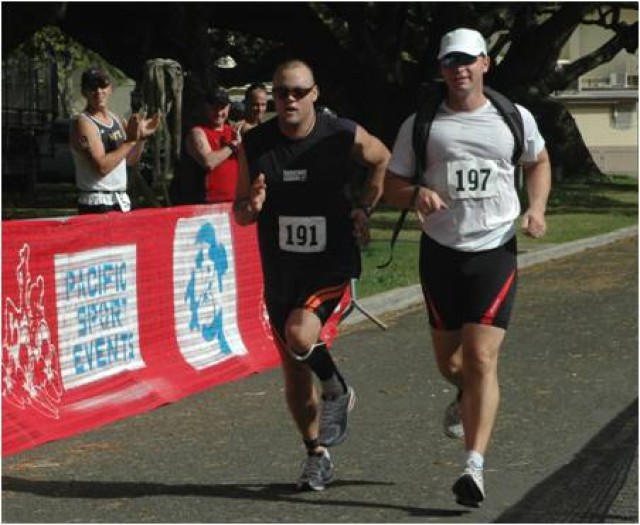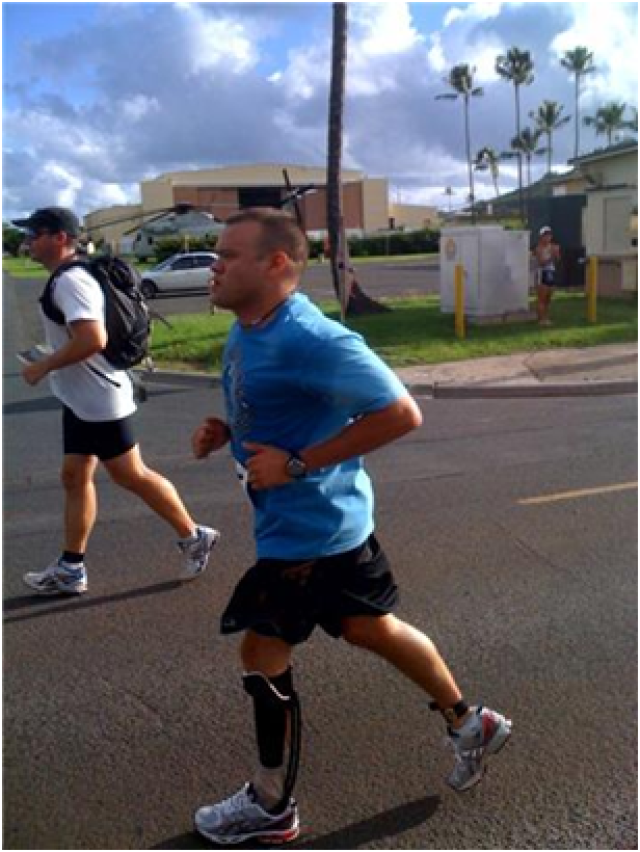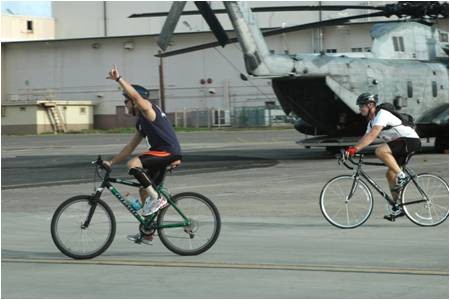Marine Corps Base Hawaii-Completing a biathlon is, to say the least, an accomplishment; but completing a triathlon two weeks later is amazing - to do so without the ability to move your left foot is inspiring.
CPT Ray O'Donnell, a member of Headquarters and Headquarters Company, 2nd Stryker Brigade Combat Team, 25th Infantry Division, Schofield Barracks, completed these amazing feats with the help of the revolutionary dynamic ankle-foot-orthosis (AFO) devise.
"I was able to finish the Oct. 17 500 meter swim and five kilometer HSL-37 "Easyriders" Splash and Dash Biathlon in a time of 1:00.29," said O'Donnell.
Just 15 days later, on Nov. 1, O'Donnell completed the Tradewinds Triathlon in a time of 1:57.09.
Held at Marine Corps Base Hawaii as well, this race added an 11.1 mile bike race to the 500 meter swim and five kilometer run.
Injured when he was ejected during a HUMVEE rollover in Afghanistan, O'Donnell sustained multiple injuries, to include traumatic brain injury, facial fractures, crushed pelvis, spinal damage, fractured hip, fractured hip socket, dislocated femur and severe nerve damage.
One of the lasting effects is the near total paralysis of his lower left leg.
He was medically evacuated to Walter Reed Army Medical Center and spent time at Brooke Army Medical Center and the Tampa Veteran Administration's Polytrauma Center.
Undergoing countless surgeries, he was confined to a bed for two months and then a wheelchair for another four months, spending a total of eight months in the hospital.
Despite the pain and 27 months of grueling physical therapy, he regained the ability to walk - but walking wasn't good enough for him.
"I wanted to prove that highly motivated Soldiers, Marines, Sailors and Airman could be retained in the military after life-altering injuries," he said.
O'Donnell tried several braces and orthoses, none of which allowed him to successfully run. After researching different options, he contacted the San Diego Company, Dynamic Bracing Solutions.
With the assistance of Brig, Gen. Steve Jones, Pacific Regional Medical Command and Tripler Army Medical Center commander, O'Donnell became the first Soldier to receive this dynamic ankle/foot orthoses,
"Since I received my orthoses, another four Soldiers, a Marine and a Navy diver have been fitted with this device with amazing results," he said.
Working at the TAMC Physical Medicine Department, O'Donnell has not only re-learned how to run, but has completed agility drills, to include the ability to again run up hills. These are activities required during combat situations.
Putting this device through its paces, demonstrates that military members with limb salvages can improve their overall function.
"Four weeks ago, Dave Newman, my physical therapist, challenged me to complete the biathlon," said O'Donnell. "We had been steadily ramping up the distance. He swam and ran by my side, encouraging me and making sure that I finished. I literally had tears in my eyes when I crossed the finish line.
"I felt a tremendous sense of accomplishment. It was my greatest physical feat since sustaining my injuries," said O'Donnell.
Rather than taking some time off to recuperate, O'Donnell pushed forward, his sights set on the Nov. 1 triathlon.
After testing to make sure that he could pedal a bike while wearing his AFO, he borrowed a mountain bike and entered the triathlon.
"Biking along the runway was beautiful. But, the headwind was a killer. I was spent by the time we were halfway through the bike portion," said O'Donnell.
After a quick transition, he began the 5 kilometer run. Much to his chagrin, it was mostly uphill.
"There was no way I was going to stop running, even if it meant taking small steps up that hill."
At one point, he lost feeling in his good foot, but the AFO held up perfectly so he just kept going.
Two years to the day after his injury, O'Donnell finished the triathlon. Coming down the final straightaway he was met by a crush of cheering fans and competitors.
"It felt awesome finishing that race," O'Donnell said.
O'Donnell continues to be an advocate for military members going through similar injuries and rehabilitation.
"My next physical objective is to pass the Army Physical Fitness Test (APFT); not the alternate event (for injured Soldiers), but the actual APFT that all healthy soldiers must take.
"My professional goal is to be able to continue serving in the Army as an Infantry Officer," said O'Donnell.






Social Sharing